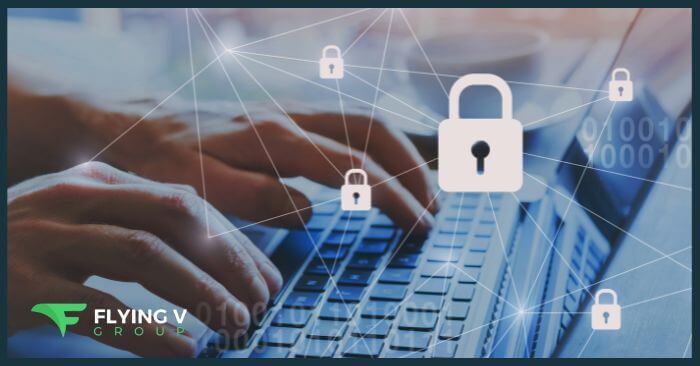In today’s digital-first world, marketers like you are no longer just creators of catchy campaigns and brand stories. You’re also guardians of sensitive customer data, from email addresses to payment details. With great data comes great responsibility—and that’s where cybersecurity compliance comes in.
If you’re thinking, ‘Cybersecurity? That’s IT’s job,’ think again. As a marketer, you play a critical role in ensuring your organization stays compliant with data protection laws and industry standards to avoid costly breaches. This post will discuss what you need to know to stay ahead of the game when it comes to cybersecurity compliance and how it’s important to a marketer’s job like yourself.
- Understand the Basics of Cybersecurity Compliance
- Know the Data You Handle
- Implement Strong Data Collection Practices
- Protect the Data You Have Collected
- Be Transparent with Your Audience
- Train Your Team on Cybersecurity and Regulatory Requirements Topics
- Cooperate Closely with Your Information Technology (IT) and Legal Departments
- Take Advantage of Technology to Remain Compliant
- Prepare for the Worst
- What is the Role of Automation in Regulatory Compliance
- The Importance of Third-Party Vendors to Achieving Cybersecurity Compliance
- What is the Future of Cybersecurity Compliance
- Final Statement
Understand the Basics of Cybersecurity Compliance
Cybersecurity compliance isn’t just a buzzword—it’s a set of rules and standards designed to protect sensitive information. These rules surrounding cybersecurity framework are often dictated by laws specific to countries and/or states, or industry-specific regulations.
At its core, compliance means ensuring that the data you collect, store, and use is handled ethically under strict security controls. For marketers, this includes everything from email lists to customer behavior analytics. Ignoring compliance can lead to hefty fines, legal trouble, and a damaged reputation.
Know the Data You Handle
As a marketer, you likely work with a ton of data. This could include:
- Personal Identifiable Information (PII) such as names, email addresses, phone numbers, and the like;
- Payment information like credit card details, billing addresses, and so on;
- Behavioral data of clients – this can be in the form of website visits, click-through rates, purchase history, and others.
Each type of data comes with its own set of compliance requirements. For example, there are laws requiring explicit consent from users before collection, while payment information must adhere to financial security-related rules.
Take inventory of the data you handle and map it to the relevant regulations. This will help you identify potential gaps in your compliance strategy.
Implement Strong Data Collection Practices
Your compliance journey starts at the very beginning: data collection. Here’s how to get it right
Obtain Explicit Consent
Always ask for permission before collecting data. Use clear, concise language to explain what data you’re collecting and why. For example, instead of a vague ‘Sign up for updates,’ try ‘Subscribe to our newsletter for exclusive offers and updates. Your email will only be used for this purpose.’
Minimize Data Collection
Collect only what you need. The less data you have, the less you have to protect. For instance, do you really need a customer’s birthdate for a newsletter signup? Probably not
Utilize Secured Forms
Ensure that any forms on your website are encrypted. This protects data as it’s transmitted from the user to your server.
Don’t worry if you don’t know anything about secured data collection. You can reach out to technology companies out there to help you. For instance, experts at MooIT and others like them can guide marketers like yourself about how to uphold cybersecurity compliance frameworks when conducting data collection.
Protect the Data You Have Collected
Once you’ve collected data, it’s your responsibility to keep it safe. Here’s how:
- Encrypt sensitive information. Why take this step? Encryption scrambles data so it’s unreadable to unauthorized users. Make sure all sensitive data, both in transit and at rest, is encrypted.
- Limit access to data – not everyone in your organization needs access to customer data. Use role-based access controls to ensure only authorized personnel can view or edit sensitive information.
- Download security updates on a regular basis. Outdated software is a goldmine for cyber threats deployed by hackers. Keep your marketing tools and security management systems up to date with the latest security patches. If you need help keeping your systems updated, you can partner with technology experts at MC Services and others like them.
Be Transparent with Your Audience
Transparency isn’t just good ethics—it’s good business. Customers are more likely to trust brands that are upfront about how their data is used.
For starters, you need to have a clear privacy policy in place. Your privacy policy should be easy to find and understand. Avoid legal jargon and clearly outline what data you collect, how it’s used, and how it’s protected.
In the event of a data breach caused by cyber threats, communicate with your stakeholders promptly. Notify affected customers as soon as possible and explain what steps you’re taking to resolve the issue. Don’t leave your whole team in the dark as well – inform them of the incident to move forward.
Train Your Team on Cybersecurity and Regulatory Requirements Topics
Cybersecurity compliance isn’t a one-person job. Your entire team needs to be on board. Empower everyone by providing learning opportunities that cover a variety of subjects: from various regulatory requirements based in your industry to cybersecurity risk assessments.
To begin, you need to regularly train your team on data protection best practices. This includes recognizing the significance of regular risk assessments to prevent potential security incidents, using strong passwords, and understanding compliance requirements.
Aside from that, you need to carry out simulated attack scenarios. This practice can help your team identify and avoid real threats. Indeed, it’s a hands-on way to reinforce training.
Finally, make sure everyone in your team knows their role in maintaining compliance and upholding cybersecurity. For example, who’s responsible for updating software? Who handles breach notifications? Assign clear roles and responsibilities to each team member from the get-go.

Cooperate Closely with Your Information Technology (IT) and Legal Departments
Cybersecurity compliance is a team effort. Collaborate with your IT and legal departments to ensure you’re meeting all requirements. Check out the following tips to help you foster a fruitful relationship with them:
- Conduct regular audits. They can help you identify vulnerabilities and ensure you’re staying compliant. Work with IT to review your data handling processes and make improvements as needed. Aside from that, your company’s legal team can undergo regular audits to check on the legal compliance side of things as part of your overall robust security policy.
- Stay updated on all relevant regulations. Data protection laws are constantly evolving. Your legal team can help you stay informed about new regulations and how they impact your marketing efforts.
Take Advantage of Technology to Remain Compliant
Technology can be your best friend when it comes to compliance. Top tools to consider include customer data platforms (CDPS), email marketing tools, and data loss prevention (DLP) software. Learn more about each one below:
- CDPs help you manage and organize customer data in a secure, compliant way – helping you avoid legal penalties. Look for platforms with built-in encryption and access controls.
- Choose email marketing tools that comply with regulations. Luckily, many platforms offer features like double opt-in and easy unsubscribe options – making it easy for you to build trust with customers.
- DLP software monitors and protects sensitive data, preventing unauthorized access and upholding privacy rights.
Prepare for the Worst
Sadly, even with the best precautions set up in place, breaches can happen. That’s why it’s crucial to have a response plan in place.
First, curate a cybersecurity incident response plan. Your plan should outline the steps to take in the event of a breach, including who to notify and how to contain the damage. Make sure that everyone in your team has been informed and onboarded about the plan.
Keep in mind the following: cybersecurity isn’t a one-time effort. Thus, you need to regularly test your incident response plan to ensure it’s effective. This will help you identify any gaps and make improvements. If a breach occurs, conduct a post-mortem analysis to understand what went wrong and how to prevent it in the future.
What is the Role of Automation in Regulatory Compliance
Automation can be a game-changer for marketers looking to streamline compliance efforts. Here’s how:
Automate Data Mapping
Data mapping tools can help you track where data is stored, how it’s used, and who has access to it. This makes it easier to identify and address compliance gaps.
Using Artificial Intelligence (AI) to Detect Security Breaches
Artificial intelligence can analyze patterns and detect potential security threats in real time. This proactive approach can help you address vulnerabilities before they become major issues.
Implement Consent Management Platforms (CMPs)
CMPs automate the process of obtaining and managing user consent. They ensure that your data collection practices are always in line with regulations like GDPR.
The Importance of Third-Party Vendors to Achieving Cybersecurity Compliance
Marketers often rely on third-party vendors for tools like analytics, email marketing, and customer relationship management. Nonetheless, these vendors can also pose compliance risks. Consider the following to be on the safe side:
- Vet your vendors. Before partnering with a vendor, conduct a thorough review of their security practices. Do they comply with relevant regulations? How do they handle data breaches following cybersecurity requirements?
- Include a strict ‘compliance clause’ in vendor contracts. Make sure your contracts with vendors include clauses that require them to adhere to data protection laws and cybersecurity controls. This protects your organization in case of a breach.
- Keep an eye on your vendors’ performance. Regularly review your vendors’ security practices to ensure they’re maintaining compliance. If they fall short, don’t hesitate to switch to a more secure provider.
What is the Future of Cybersecurity Compliance
As technology evolves, so do the challenges of cybersecurity compliance. Here’s what to watch for:
- Governments around the world are introducing stricter data protection laws. Stay informed about upcoming regulations and prepare your organization to adapt to avoid dealing with significant financial losses.
- Consumers are becoming more aware of their data rights. Brands that prioritize privacy will have a competitive edge.
- From blockchain to quantum encryption, new technologies are emerging to enhance data security. Keep an eye on these developments and consider how they can benefit your organization.
Final Statement
Cybersecurity compliance may seem daunting, but it’s an essential part of modern marketing. By understanding the regulations, protecting customer data, fostering a culture of security among your team through training, and so on, you can turn compliance into a competitive advantage. Remember, it’s not just about avoiding risks—it’s about building trust and creating a safer digital ecosystem for everyone.






0 Comments